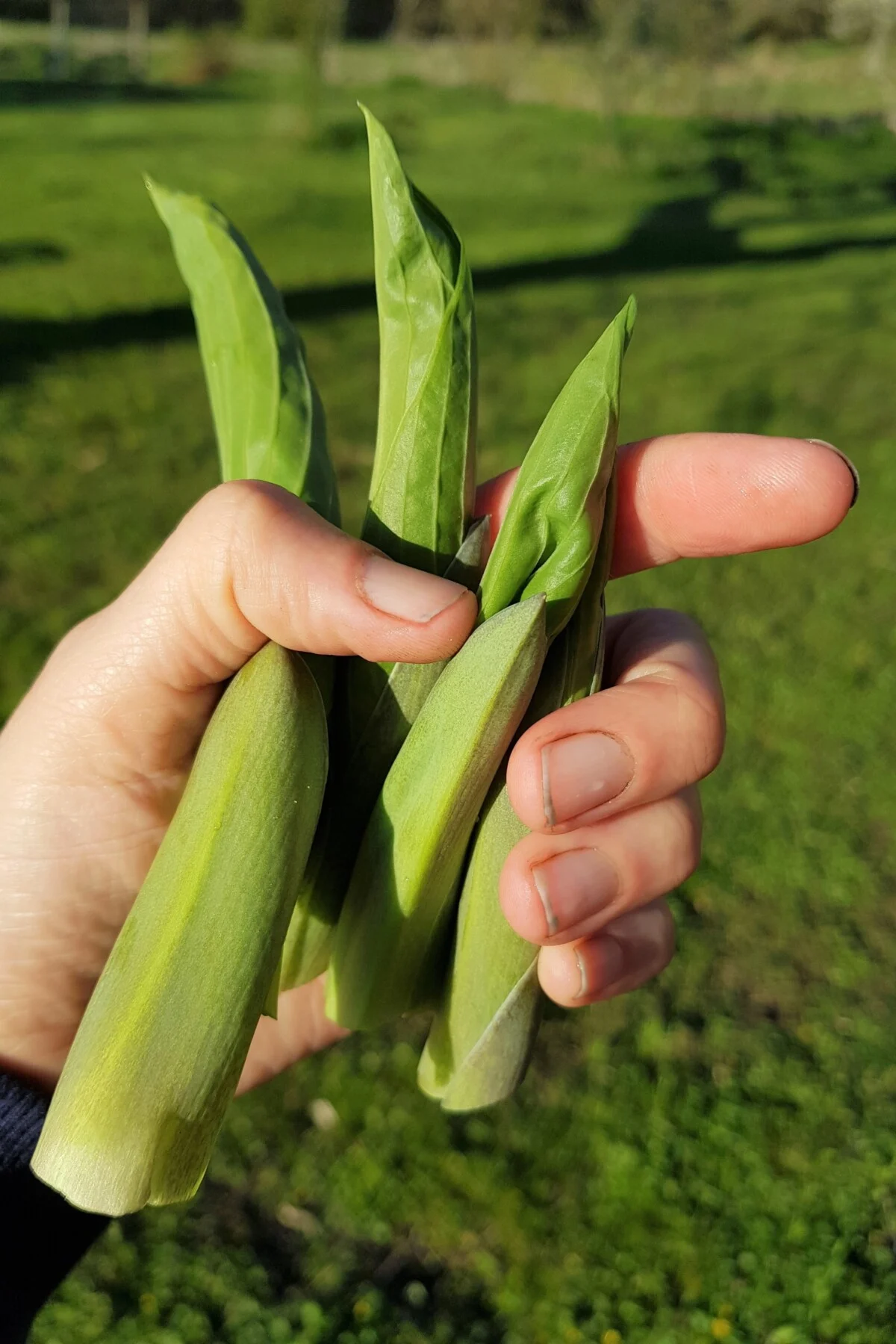
I first came across the term “edimental” when I was looking up whether I could eat this mesmerizing little plant that I had bought on impulse. It’s called purple Shiso (aka Perilla frutescens var. crispa) and even though it looks ornamental, it is very much an edible plant. The leaves taste like cumin seeds with a light citrusy aftertaste.
This is the entire point of edimentals, a word that describes plants that are both ornamental and edible.
The portmanteau term – popularized by gardener and writer Stephen Barstow – is becoming more and more common with home gardeners and garden designers alike.

I think that gardening with edimentals is less of a how-to and more of a philosophy. Sure, we use them anyway when we scatter around beautiful edible flowers such as calendula, nasturtiums and pansies in our veggie patches. But there are so many more edimentals to discover (more on that below) and so many ways to incorporate them into our growing spaces and our meals.
I’ve only just started to discover this fascinating world of edible ornamental plants, and I have to warn you that it’s very much a rabbit hole of information and knowledge. (But not the kind of rabbit hole that gardeners hate.) The deeper I dive, the more I want to know.
Here are a few things you should know about planting more edimentals in your garden.
1. So many edimentals are perennials.
I thought I’d start with the extra good news. A lot of these plants that are both edible and ornamental are perennials. I love gardening with perennials, and if I weren’t such a big fan of tomatoes and snap peas, I’d have perennials as my main source of food from the garden.
It’s not just the money-saving aspect of perennials that I’m mostly interested in.

Even though I admit that the time-saving and energy-saving aspects play a big part – I don’t have to re-sow perennials – there are some other added advantages.
Perennial edimentals are more likely to be resistant to droughts (because of their strong roots) and to pests (due to interspersed seeding). They also contribute to a healthy soil structure, since we don’t pull them out at the end of every growing season.
2. Edimentals will benefit wildlife too.
Stephen Barlow also uses the term ‘entomentals’ to refer to plants that are edible, ornamental and beneficial for insects (entomology) and wildlife. So in addition to serving a decorative and a nutritional purpose, they also serve an entomological one.

You’ll see that a lot of the plants on my list below produce a lot of pollen-filled flowers. That, combined with their perennial nature, means they’ll keep growing in our gardens and attracting more and more pollinator friends every year.
3. There is so much food variety with edimentals.
When you think of ornamentals that we can eat, you might just be thinking of edible flowers. While it’s nice to sprinkle violas, calendula, oxalis, nasturtium and borage flowers on our salads, there’s more to edimentals than just using them as a garnish.

There are ornamental herbs with edible leaves, such as tulsi, oregano and Salvia macrophylla. Then there are the edible bulbs, such as those of the perennial leeks (Allium babingtonii), walking onions and sun artichokes. Let’s not forget shrubs, such as Sambucus nigra; Beans, such as scarlet runner beans; and the fleshy colorful stems of rhubarb and chard.
It’s not just flowers, folks!
4. You can weave edimentals into any existing garden.
Chances are we probably already have some edimentals growing in our gardens as we speak. So we don’t really need a complete overhaul to start an edimental garden.

The way I’ve been doing it is by introducing a few edible ornamentals to the garden every spring and fall, usually to fill in a gap for a plant that didn’t make it that growing season. I built my garden over several years, and every time I created a new garden bed, I added some perennial edibles to it.
My biggest success so far has been growing perennial wild strawberries (Fragaria vesca), an excellent ground cover with multiple juicy raspberry harvests a year. It’s followed closely by perennial greens such as red-veined sorrel (Rumex sanguineus) and perennial herbs, such as flowering sage.
Everywhere I turn in my garden now, there’s something to pick and nibble on, whether it’s berries, roots, leaves or bulbs. It’s like foraging every day in my own back yard.

5. Edimentals will expand your palate.
I was never what you’d call a picky eater, but neither was I very adventurous in my food choices. Until I started gardening, that is.
Nowadays, I like to think of my taste buds as a work in progress. If given the chance, my taste will develop and widen alongside my edimental garden. It’s one of the most enriching experiences I can think of – the first time you eat something new that you’ve grown and go “hmm, yes, this tastes like …”

And the feeling of satisfaction I get when I share it with (usually unsuspecting) friends and family is off the charts. I’m not just an adventurous gardener now but an adventurous eater as well.
It’s not always love at first bite, though. It took many tries before I’ve come to love (and crave) artichokes, for example. So if you’re still reluctant to munch on some of your edimental plants, I encourage you to try it at least three times, preferably prepared in different ways or accompanied by various other ingredients.
6. Edimentals can skirt HOA rules.
I left this one last because, honestly, it makes my blood boil a little. I’ve never lived in a house under the rule of a Homeowners’ Association (HOA). But I know from friends and from various gardening groups that there are HOAs that prohibit growing your own vegetables. It’s ridiculous, but it’s a reality for some people.

One way to skirt this nonsensical rule is by planting edimentals instead. Your garden will look like it’s full of nothing but ornamental plants, but you can also sneakily harvest some food from it.
A quick disclaimer
Before we dive into the list of edimentals, let me add this quick disclaimer. Before you buy or eat anything from the garden, please do your own due diligence. Make sure that you know exactly what you’re growing and consuming. Some plants are pretty easy to identify, while others need a double-check because they have non-edible look-alikes.
It’s also super important to know what parts of the plant are edible and whether they can be consumed raw or cooked. Some plants may require drying, cooking or pickling to make them suitable for consumption.

A good source of information for edible plants is the database at Plants for a Future, a charity promoting ecologically sustainable horticulture. This resource also includes notes on preparation and possible toxicity of certain plants.
There are also online nurseries that specialize in edimentals. And each nursery-bought plant should come with either an edible or ornamental label.
And last but not least, have a look at Stephen Barstow’s website where he documents growing over two thousand edible plants in this garden in Norway. He also wrote a book called Around the World in 80 Plants: An edible perennial vegetable adventure for temperate climates which takes plants from all continents and explains how they fit into a temperate garden.
80 Edimentals to Plant in Your Garden
Here are a few plants to get your edimental garden started. I’ve tried to organize them into categories, but there’s definitely some overlap. For example, for chives, the leaves and the flowers are edible, but I’ve added it under Alliums.
Once again, I’ll direct you to the PFAF database to see what part of the plant is edible.
Leaves or Greens
Caucasian spinach (Hablitzia tamnoides)
Turkish rocket (Bunias orientalis)
Swiss chard (Beta vulgaris)
Miner’s lettuce (Claytonia perfoliata)

Alfalfa or lucerne (Medicago sativa)
Perpetual kale (Brassica oleracea ramosa)
Hosta – Tracey shows us how to eat hosta shoots in this article.

Garden sorrel (Rumex acetosa)
Tree collards (Brassica oleraceae ‘Tree collard’)
Patience dock (Rumex patientia)
Scurvy grass (Cochlearia officinalis)
Sea kale (Crambe maritima)
Rock samphire (Crithmum maritimum)
Asturian tree cabbage
Rhubarb (Rheum rhabarbarum) – only the stalks are edible.
Roots
Turmeric (Curcuma longa)
Root ginger (Zingiber officinale) – Elizabeth wrote a super popular guide about growing ginger.
Chinese artichoke (Stachys affinis)
Chicory (Cichorium intybus) – both the leaves and the roots are edible
Sweet root or skirret (Sium sisarum)
Black salsify (Pseudopodospermum hispanicum)

Ground nut or hopniss (Apios americana)
Sun artichokes (Helianthus tuberosus) – have a look at Cheryl’s guide on growing and cooking with Jerusalem artichokes.
Earth chestnuts (Conopodium majus)
Ulluco (Ullucus tuberosus )
Yacon (Smallanthus sonchifolius)
Cinnamon yams (Dioscorea batata)
Arrowleaf balsamroot or Balsan sunflower (Balsamorhiza sagittata)
Herbs
Lemongrass (Cymbopogon citratus)
Baby sage (Salvia microphylla)
Shrub sage (Salvia officinalis ‘Berggarten’)

Holy basil or tulsi (Ocimum tenuiflorum)
Pineapple sage (Salvia elegans)
Purple Shiso or perilla (Perilla frutescens)
Garden angelica (Angelica archangelica)
Lovage (Levisticum officinale)
Valerian (Valeriana officinalis)
Sweet fennel (Foeniculum vulgare)
Lavender (Lavandula angustifolia)

Hyssop (Hyssopus officinalis)
African blue basil (Ocimum kilimandscharicum × basilicum ‘Dark Opal’)
Thai basil (Ocimum basilicum var. thyrsiflora)
Bee balm or wild bergamot (Monarda)
Sweet cicely (Myrrhis odorata)
Oregon ginseng or California ginseng (Aralia californica)
French tarragon (Artemisia dracunculus var. sativa)
Chervil (Anthriscus cerefolium)
Alliums
Elephant garlic (Allium ampeloprasum)
Chives (Allium schoenoprasum)
Wild leek (Allium babingtonii)

Perennial onion (Allium fistulosum)
Nodding onion (Allium cernuum)
Egyptian walking onion (Allium cepa proliferum)
Flowers
Globe artichokes (Cynara cardunculus var. scolymus) and cardoons (Cynara cardunculus, also known as thistle artichokes)
Daylilies (Hemerocallis fulva)
Sunflowers (Helianthus annus)
False shamrock (Oxalis triangularis)
Saffron crocus (Crocus sativus)

Cornflower (Centaurea cyanus)
Hibiscus (Hibiscus sabdariffa) – the dry flowers of this variety make excellent teas.
Calendula (Calendula officinalis)
Coneflower (Echinaceea purpurea)
Dahlias – the petals are edible
Nasturtium (Tropaeolum majus) – Madison shares fifteen uses for this abundant plant.
Chamomile (Matricaria chamomilla)

Mallow (Malva)
Meadow checker mallow (Sidalcea campestris)
Narrow-leaf mule’s-ears or California compass (Wyethia angustifolia)
Primrose (Primula)
Amaranth (Amaranthus)
Sweet violet (Violeta odorata)
Shrubs
Partridge berry (Mitchella repens)
Magnolia – you can even pickle magnolia flowers, but don’t eat the seed pods
Forsythia – the flowers are edible

Roses – most rose hips are edible, but I especially like those of wilder varieties, such as Rosa canina.
Hawthorn (Crataegus oxyacanthoides)
Thimbleberry (Rubus parviflorus)
Flowering quince (Chaenomeles)
Bay laurel (Laurus nobilis)
Elderflower (Sambucus nigra)
Currants and gooseberries (Ribes)
Eastern redbud (Cercis canadensis)
While you’re at it, have a look at Elizabeth’s article on edible privacy screens, most of which are shrubs.
There are so many edimentals to discover and it feels like I’ve just begun to scratch the surface. But once I got into the mindset of combining beauty and function, it opened up a more holistic view of gardening. My purpose is shifting more towards getting the best of both worlds – the functionality of a kitchen garden combined with the beauty of ornamental flower beds.

Get the famous Rural Sprout newsletter delivered to your inbox.
Including Sunday ramblings from our editor, Tracey, as well as “What’s Up Wednesday” our roundup of what’s in season and new article updates and alerts.


